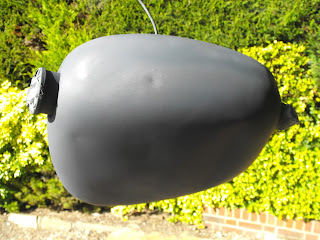 |
| At the bottom of the picture, the protrusion from the frame is what the bolt bolts into. |
I have removed the rear mudguard for some attention. It is very simple to do, as there are only 4/5 bolts holding it on, one of which I have removed already with the oil tank. There is a bolt on the left hand side holding it onto the frame, which should be removed. Be careful that the spacer doesn't get lost.

Then remove the two bolts under the seat holding it onto the frame. I didn't have any more bolts to undo, but check to see just in case. Lift the mudguard up to see the wire. There are two wires running from the main loom into the mudguard, one brown and one black. There should be a bullet plug in each at the bike end, which should be disconnected. The mudguard then lifts out.

On the underside, I noticed that the screw heads have red paint on them. This might be another indication of the mudguard having been resprayed.

Undo the 4 screws holding the light/number plate unit on, and remove the whole assembly.

Carefully, peel the rubber on the reflector back from the silver ring, and remove the silver piece and reflector. there should be a small bolt behind, holding it onto the mudguard. Undo this and remove the reflector.
I spent 2 hours cleaning all the muck off it, and discovered an interesting fact. Where the paint was peeling, what looks to be chroming is showing through. This solves a long standing question of why the bike had a painted rear mudguard, and whether that was just an option when new, as it must have been chrome in its past life.
 |
| Chrome peeking through |
 I have sent an enquiry to a local chroming place to see roughly how much it will cost to get this rechromed, so hopefully that will give me some idea, but before then, I want to try and get it shaped as well as I can.
I have sent an enquiry to a local chroming place to see roughly how much it will cost to get this rechromed, so hopefully that will give me some idea, but before then, I want to try and get it shaped as well as I can.I have used paint stripper to get all the paint off, revealing the chrome. I can now work on knocking out dents and reshaping without worrying about forcing specks of paint into the metal.













































